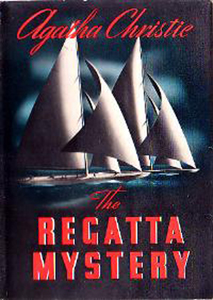Prior to “The Regatta Mystery and Other Stories” (1939), Agatha Christie seemed to think of her short stories in terms of collections under the banner of one detective (or detective duo). Even though her shorts were always published in magazines first, she liked having them fit into a larger whole.
This is especially apparent with the Tommy & Tuppence and Mr. Quin collections, in which each chapter stands alone but is also part of a larger narrative.
The experiment works OK in those cases, not so much in “The Big Four,” wherein Christie’s brother stitched together into a novel Christie’s Poirot stories that make mention of a sinister cabal lurking in the background.

“The Regatta Mystery and Other Stories” (1939)
Author: Agatha Christie
Genre: Mystery short stories
Series: Hercule Poirot No. 20
Settings: England and Europe, 1930s
Other characters: Miss Marple, Parker Pyne
All hands on deck
In the Thirties, Christie stops putting her stories under wider umbrellas and simply writes about Poirot, Marple and Parker Pyne when and where she pleases. The result is “The Regatta Mystery and Other Stories,” which has no overarching linkage. It’s simply nine good to great yarns by a master of her craft.
We get five Poirots, two Pynes, a Marple and one that features none of them. The original printings run from 1932-39.
The title is evocative of a setting, but that’s a tease. The book-launching “Regatta Mystery” (originally published in 1936, but with Poirot changed to Pyne here) takes place at a dinner of revelers after an off-page yachting festival. But I guess they had to call the book something.
A lot of Christie’s tropes are on display in this collection, wielded with her usual skill. If I want to be picky, several of these yarns couldn’t be easily told in screen adaptations, as they involve false faces or performances or faked deaths that a reader can’t see through but a viewer could. That doesn’t hamper the fun factor all that much though.
The best entries
Although I found myself scanning for Poirot’s name and being delighted that he stars in five stories, my two favorites in the collection are the Marple and a Pyne.
In “Miss Marple Tells a Story” (published for the first time here, with Christie adapting it from her 1934 radio play), a man who is wrongly accused of murder applies the “get a second opinion” philosophy of health to legal defense. His second opinion is from Marple. He tells her all the details of the case and she deduces what really happened.
The vacationing Pyne (who is less enthusiastic than Poirot about having his days off interrupted by a case) is at his most clever in “Problem at Pollensa Bay” (1936).
He figures out how to manipulate a woman into approving of her son’s fiancée by introducing other characters into the mix. I think this story benefitted from me not having read several Pynes heading into it.

Others of interest
“In a Glass Darkly” (1934), the story that lacks a detective, is one of those Christie yarns that pushes the supernatural boundary. It’s a good fable about appreciating what you have, rather than worrying about bad things that might happen.
It pairs nicely with “The Dream” (1937), a Poirot tale that seems to likewise invoke message from the beyond but instead uses it as a red herring.
Christie nerds will find “Yellow Iris” (1937) of interest because it was later expanded into “Sparkling Cyanide,” an oft-adapted novel that replaces Poirot with Colonel Race.
When I first plunged into Christie’s short story collections, I noted that I like the novels much better. The gap is narrowing. “The Regatta Mystery and Other Stories” is a light yet consistently engaging read, front to back.
Every week, Sleuthing Sunday reviews an Agatha Christie book or adaptation. Click here to visit our Agatha Christie Zone.

